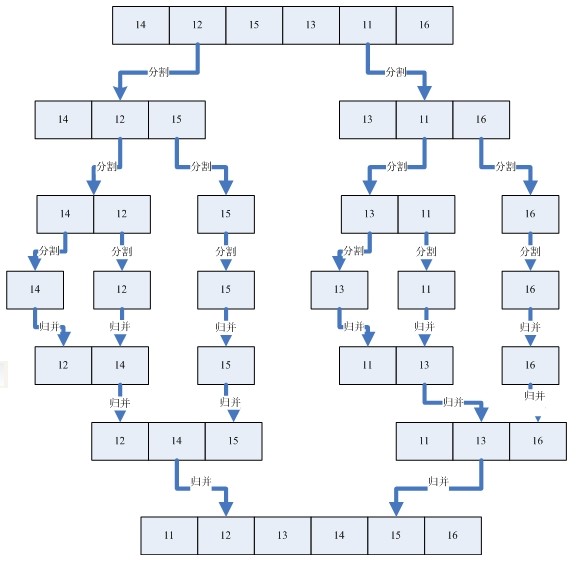1. 冒泡排序
原理:比较两个相邻的元素,将值大的元素交换至右端。
思路:依次比较相邻的两个数,将小数放在前面,大数放在后面。即在第一趟:首先比较第1个和第2个数,将小数放前,大数放后。然后比较第2个数和第3个数,将小数放前,大数放后,如此继续,直至比较最后两个数,将小数放前,大数放后。重复第一趟步骤,直至全部排序完成。
/* * 冒泡排序 */ public class BubbleSort { public static void main(String[] args) { int[] arr={6,3,8,2,9,1}; System.out.println("排序前数组为:"); for(int num:arr){ System.out.print(num+" "); } for(int i=0;i<arr.length-1;i++){//外层循环控制排序趟数 for(int j=0;j<arr.length-1-i;j++){//内层循环控制每一趟排序多少次 if(arr[j]>arr[j+1]){ int temp=arr[j]; arr[j]=arr[j+1]; arr[j+1]=temp; } } } System.out.println(); System.out.println("排序后的数组为:"); for(int num:arr){ System.out.print(num+" "); } } }
2.直接插入排序
从第一个数开始遍历,将每次遍历的数都插入到前面的有序数组中,(待插入值与前面的数比较,将大于temp的数后移,最后插入temp到 a[j+1]位置)
//直接插入排序 for(int i=1;i<a.length;i++){ int temp=a[i];//新遍历的值,等待插入前面已排好序的有序数组 int j; //将大于temp的数后移 for(j=i-1;j>=0;j--){ if(a[j]>temp){ a[j+1]=a[j]; } else{ break; } } a[j+1]=temp; }
3.二分插入排序
与直接插入排序原理一样,只是将查找插入位置变成二分查找方式
public static void main(String[] args){ int[] a={34,12,3,22,78,1,98,66,55,44,7,3,1,0,-1}; for(int i=1;i<a.length;i++){ int temp=a[i]; int left=0; int right=i-1; //接下来二分查找比a【i】小的数的最右边位置 while(left<=right){ int mid=(left+right)/2; if(temp<=a[mid]){ right=mid-1; }else{ left=mid+1; } } //最后left就是要插入的位置left后到i-1的数据要后移 for(int j=i-1;j>=left;j--){ a[j+1]=a[j]; } //最后将a[i]插入到序列中 a[left]=temp; } for(int val:a){ System.out.println(val); } }
4. 希尔排序(又称为增量排序)
是一种不稳定排序,思路:
- 首先将待排序的一组数按某个增量分为若干子序列,并对子序列分别进行插入排序或者其他排序方式排序(以下代码是其他方式排序的)。
- 然后逐渐将增量减小,并重复上述过程。直至增量为1,此时数据序列基本有序,最后进行一次插入排序。
public static void main(String[] args) { // TODO Auto-generated method stub int[] a={49,1,8,79,65,34,22,19,7,40,80,89}; int d=a.length; while(true){ d=d/2; //分为d组数,需要对每组排序(采用以下排序方式),共d趟 for(int i=0;i<d;i++){ //组内排序 //外层循环只是对小组内的数排序完所需要的趟数 for(int j=i;j+d<a.length;j+=d){ //内循环两两比较,如需要则进行交换 for(int n=i;n+d<a.length;n+=d){ int temp;//前边大于后边,交换 if(a[n]>a[n+d]){ temp=a[n+d]; a[n+d]=a[n]; a[n]=temp; } } } } if(d==1){break;} } for(int k=0;k<a.length;k++){ System.out.println(a[k]); } }
//普通排序 希尔排序用到这个思想 public static void main(String[] args){ int[] a={8,5,7,2,10,9}; int temp; for(int i=0;i<a.length-1;i++){ for(int j=0;j<a.length-1;j++){ if(a[j]>a[j+1]){ temp=a[j+1]; a[j+1]=a[j]; a[j]=temp; } } } for(int k=0;k<a.length;k++){ System.out.println(a[k]); } }
5. 两路归并排序
算法思路:分而治之(divide - conquer);每个递归过程涉及三个步骤:
第一, 分解: 把待排序的 n 个元素的序列分解成两个子序列, 每个子序列包括 n/2 个元素.
第二, 治理: 对每个子序列分别调用归并排序MergeSort, 进行递归操作
第三, 合并: 合并两个排好序的子序列,生成排序结果.

public static void main(String[] args) { // TODO Auto-generated method stub int[] a={49,1,8,79,65,34,22,19,7,40,80,89}; int d=a.length; while(true){ d=d/2; //分为d组数,需要对每组排序(采用以下排序方式),共d趟 for(int i=0;i<d;i++){ //组内排序 //外层循环只是对小组内的数排序完所需要的趟数 for(int j=i;j+d<a.length;j+=d){ //内循环两两比较,如需要则进行交换 for(int n=i;n+d<a.length;n+=d){ int temp;//前边大于后边,交换 if(a[n]>a[n+d]){ temp=a[n+d]; a[n+d]=a[n]; a[n]=temp; } } } } if(d==1){break;} } for(int k=0;k<a.length;k++){ System.out.println(a[k]); } } //普通排序 希尔排序用到这个思想 public static void main(String[] args){ int[] a={8,5,7,2,10,9}; int temp; for(int i=0;i<a.length-1;i++){ for(int j=0;j<a.length-1;j++){ if(a[j]>a[j+1]){ temp=a[j+1]; a[j+1]=a[j]; a[j]=temp; } } } for(int k=0;k<a.length;k++){ System.out.println(a[k]); } } 5. 两路归并排序 算法思路:分而治之(divide - conquer);每个递归过程涉及三个步骤: 第一, 分解: 把待排序的 n 个元素的序列分解成两个子序列, 每个子序列包括 n/2 个元素. 第二, 治理: 对每个子序列分别调用归并排序MergeSort, 进行递归操作 第三, 合并: 合并两个排好序的子序列,生成排序结果. public static int[] sort(int[] a,int low,int high){ int mid = (low+high)/2; if(low<high){ sort(a,low,mid); sort(a,mid+1,high); //左右归并 merge(a,low,mid,high); } return a; } public static void merge(int[] a, int low, int mid, int high) { int[] temp = new int[high-low+1]; int i= low; int j = mid+1; int k=0; // 把较小的数先移到新数组中 while(i<=mid && j<=high){ if(a[i]<a[j]){ temp[k++] = a[i++]; }else{ temp[k++] = a[j++]; } } // 把左边剩余的数移入数组 while(i<=mid){ temp[k++] = a[i++]; } // 把右边边剩余的数移入数组 while(j<=high){ temp[k++] = a[j++]; } // 把新数组中的数覆盖nums数组 for(int x=0;x<temp.length;x++){ a[x+low] = temp[x]; } } public static void main(String[] args) { int[] num = { 1, 5, 3, 2 }; sort(num, 0, num.length - 1); for (int i = 0; i < num.length; i++) System.out.print(num[i] + " "); }